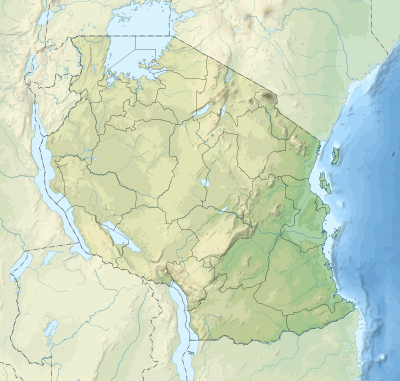Pugu Hills Forest Reserve
| Pugu Forest Reserve | |
|---|---|
|
The reserve was created to protect the coastal forest and its endemic species | |
 Map of Tanzania | |
| Location | Pwani Region, Tanzania |
| Coordinates | 6°53′20″S 39°05′20″E / 6.889°S 39.089°ECoordinates: 6°53′20″S 39°05′20″E / 6.889°S 39.089°E[1] |
| Area | 2,179 ha (5,380 acres) |
| Established | 1954 |
The Pugu Forest Reserve is a forest reserve in Pwani Region, Tanzania. It is located in the Pugu Hills area, near Dar es Salaam, adjacent to the Kazimzumbwi Forest Reserve. Together with Kazimzumbwi, the Pugu Forest (previously known as Mogo Forest) is part of what is considered to be one of the oldest forests in the world. The area is characterized by a large number of endemic species of animals and plants.
Location
_mining_activity_at_Pugu_Hills%2C_Tanzania.jpg)
The reserve extends over a large hilly area south-west of Dar es Salaam, the nearest populated place being Kisarawe. The source of the Msimbazi river, that flows into the Indian Ocean in the surroundings of Dar, is inside the reserve. The reserve borders both the Kazimzumbwi Reserve and the Selous Game Reserve. A large fraction of its vegetation is composed of evergreen plants, as rain is common and abundant throughout most of the year. One of the largest kaolinite deposits in the world is located inside the reserve.
Environment
The Pugu Forest has 14 endemic plant species, two mammalian endemic species, and one endemic subspecies of birds. Wildlife include elephants, Masai giraffes, impalas, common warthogs, African leopards, Tanzanian cheetahs, spotted hyenas, pangolins, elephant shrews, mongooses, civets, galagos, side-striped jackals, black-backed jackals, baboons, hippopotamuses, colobuses, as well as over 80 species of birds. The Masai lions used to live in the reserve, but none has been reported in recent times. Some natural caves host large colonies of bats.
Tourism
Despite not being part of traditional touristic routes, the Reserve has a fair number of visitors per year, mainly because of its proximity to Dar es Salaam and the Julius Nyerere International Airport (20 minutes drive from the park). Trekking paths have been traced in the Reserve, leading to its main attractions, including a cave that is a sacred place to the Zaramo people, a colorful local cattle market, and some bat-populated caves (these are especially fascinating at sunset, when bat fly out of the cave in large flocks). With the permission of the Ministry of Natural Resources camping should be possible in reserve, in Pugu Kajiungeni the Pugu Hills Nature Centre a small private lodge offers the artist house, four huts on poles and opportunity for camping.
Development
The fees for the reserve are around 2 US dollars for Tanzanian citizens and 30 US dollars for foreigners (National Entrance Rate), permits can be obtained at the Ministry of Natural Resources or the Forestry office in Kisarawe town. Hiking is also possible in the hills outside the reserve.
References
- ↑ "Pugu Forest Reserve". protectedplanet.net.
| Wikimedia Commons has media related to Pugu Hills Forest Reserve. |